![]()
![]()
![]()
Use LEFT and RIGHT arrow keys to navigate between flashcards;
Use UP and DOWN arrow keys to flip the card;
H to show hint;
A reads text to speech;
40 Cards in this Set
- Front
- Back

In what class of enzymes does alcohol dehydrogenase belong? |
oxidoreductase |
|
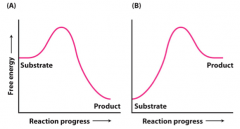
Reaction-progress curves for two different reactions are shown below. Which of the following statements is true? |
Reaction A is exergonic. Reaction B is endergonic. The activation energy for B is greater than that of A (all) |
|
|
Which of the following is INCORRECT |
Enzymes typically act under milder conditions of temperature and pH than chemical catalysts. Enzymes typically catalyze reactions at much higher rates than chemical catalysts. Enzymes catalyze reactions in the forward direction only. Enzymes are often very specific for their substrates. Enzyme activities can often be regulated. |
|
|
An enzyme will bind its substrate with high specificity due to |
a large number of weak interactions at the active site |
|
|
The x-intercept of a Lineweaver-Burk plot is |
-1/KM |
|
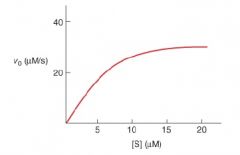
Use the velocity plot provided below to estimate values of KM and Vmax for an enzyme-catalyzed reaction |
The Vmax is approximately 30 μM/s and the KM is approximately 5μM |
|
|
All simple enzyme-catalyzed reactions yield a hyperbolic velocity curve. The shape of the curve suggests |
an enzyme-substrate (ES) complex is formed |
|
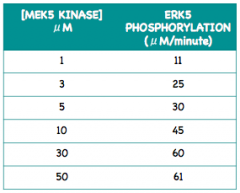
Data recorded for a kinetic analysis of the MEK5 kinase and its substrate ERK5 is shown in the table below. Based on this data, determine the VMAX and KM for the MEK5 enzyme |
VMAX = 61 μM/minute and KM = 5 μM |
|
|
Enzymes assist in the formation of a transition state intermediate by |
Preventing interference by water molecules. Positioning substrates precisely in spatial relation with one another and with specific amino acid side chains. Binding the substrate with high affinity and the product with low affinity. Playing a direct role in the reaction mechanism |
|
|
Enzymes that show allosteric regulation |
show regulation by other molecules |
|

As shown below, two pathways cooperate to form a single product. What type(s) of feedback mechanism(s) is/are depicted |
positive and negative feedback regulation |
|
|
What is the physiological significance of cooperativity in sigmoidal kinetics |
allosteric enzymes display a threshold effect below a certain substrate concentration there is very little enzyme activity for allosteric enzymes allosteric enzymes are mostly either ON (R state) or OFF (T state) |
|
|
For Michaelis-Menten enzymes, this type of inhibitor binds only to the ES (enzyme-substrate) complex |
uncompetitive inhibitor |
|
|
Succinylcholine is a fast acting, short duration muscle relaxant that is used when a tube (bronchoscope) is inserted into a patient's trachea and bronchi to look for signs of cancer. Within seconds of the administration of succinylcholine, the patient experiences muscle paralysis and is placed on a respirator while the examination proceeds. Succinylcholine is a competitive inhibitor of acetylcholinesterase, and this inhibition causes paralysis. However, succinylcholine is hydrolyzed by blood-serum cholinesterase, thus, paralysis lasts until the succinylcholine is hydrolyzed by the serum cholinesterase, usually several minutes later. Some patients have a mutant form of the serum cholinesterase that displays a KM of 10 mM, rather than the normal 1.4 mM. What will be the effect of this mutation on the patient? |
The patient will clear the drug at a much slower rate, and paralysis time will be extended |
|
![An enzyme is assayed in the presence of an inhibitor (red and green lines) or absence of an inhibitor (black line), and v is measured as a function of [S]. The double reciprocal plot obtained is shown in the figure below.Where is the inhibitor lik...](https://images.cram.com/images/upload-flashcards/33/99/55/10339955_m.jpg)
An enzyme is assayed in the presence of an inhibitor (red and green lines) or absence of an inhibitor (black line), and v is measured as a function of [S]. The double reciprocal plot obtained is shown in the figure below.Where is the inhibitor likely to bind on the enzyme? |
At a regulatory site |
|
|
The active site of acetylcholine esterase contains a powerful nucleophile reactive group that becomes temporarily covalently modified in the course of catalysis. Which catalytic strategy does acetylcholine esterase employ? |
covalent catalysis |
|
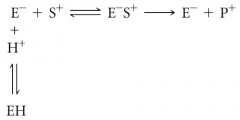
The effect of pH on the activity of an enzyme was examined. At its active site, the enzyme has an ionizable group that must be negatively charged in order for substrate binding and catalysis to take place. The ionizable group has a pKa of 6.0. The substrate is positively charged throughout the pH range of the experiment. At which pH will the velocity equal one-half of the maximal velocity attainable under these conditions? |
pH 6 |
|
|
Chymotrypsin uses the following mechanism(s) to catalyze the cleavage of a peptide bond |
covalent and acid-base catalysis |
|
|
In conducting an experiment with a new drug, you find that regardless of the concentration of substrate, the drug is able to inhibit the enzyme activity. From these data you know that the inhibitor is NOT |
competitive |
|
|
For the chymotrypsin enzyme, predict the effect of mutating the active site aspartate residue to a tyrosine |
It is likely that the mutant chymotrypsin enzyme will lose all activity |
|
|
Both myoglobin and hemoglobin can be classified as |
globular proteins |
|
|
The structure of normal hemoglobin can be best described as |
a tetramer composed of two αβ dimers |
|
|
What is the Bohr effect? |
the regulation of hemoglobin binding by hydrogen ions and carbon dioxide |
|
|
The binding of 2,3-bisphosphoglycerate to hemoglobin increases its affinity for oxygen. |
False |
|
|
In the naturally occurring D series of aldoses, the carbonyl group is found on carbon number |
one |
|
|
At equilibrium in solution, D-glucose consists of a mixture of its anomers. Which statement most accurately describes the solution? |
The β-anomer is more stable and predominates over the α-anomer by a ratio of approximately 2:1 |
|

For the sugars shown below, the enatiomer of sugar C is |
None of them |
|

Lactose is a reducing sugar |
True |
|
|
Proteins that have covalently bonded carbohydrate units attached to them are called glycoproteins. A functional group in proteins that may serve as a glycosylation site is |
hydroxyl group |
|
|
The storage form of glucose in animals is |
glycogen |
|
|
In plants glucose is stored as |
B) amylose, a linear polymer of glucose units joined by α-1,4-glycosidic bonds. C) amylopectin, a branched polymer with glucose molecules joined by α-1,4-glycosidic bonds that are linked at approximately every 30 glucose units with α-1,6-glycosidic bonds. |
|
|
Glycogen and amylopectin have the same chemical structure but different architectures |
True |
|

Identify palmitate from the following chemical representations |
Structure B |
|
|
The longer the fatty acid, the |
higher the melting point of the fatty acid |
|
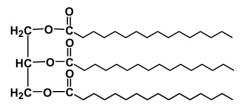
Identify the molecular structure depicted below |
Triacylglycerol |
|
|
Why are triacylglycerides well suited as energy storage compounds? |
A) Fatty acids are ionized at physiological pH and large quantities could disrupt cellular pH. B) Fatty acids can be cleaved from triacylglycerols by lipases, and then utilized to generate energy. |
|
|
Why can phosphoglycerides form membranes, while triacylglycerols cannot? |
triacylglycerols are completely nonpolar and hydrophobic triacylglycerols will aggregate together in an aqueous environment phosphoglycerides are amphiphilic, with polar heads and nonpolar tails. phosphoglycerides spontaneously arrange in bilayers, with tails aggregating, and the polar heads interfacing with the aqueous environment (all) |
|
|
Fatty acids aggregate to form spherical structures called |
micelles |
|
|
Which of the following concerning sphingolipids and phospholipids is (are) correct |
A) The backbone of phosphoglycerides is glycerol. B) The backbone of sphingolipids is sphingosine. |
|
|
Why are lipids a more efficient storage form than glycogen? |
A) Lipids are stored in an anhydrous from. B) Lipids are more reduced than glycogen. |

